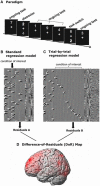Brain Signal Variability Differentially Affects Cognitive Flexibility and Cognitive Stability
- PMID: 27053205
- PMCID: PMC6705511
- DOI: 10.1523/JNEUROSCI.2517-14.2016
Brain Signal Variability Differentially Affects Cognitive Flexibility and Cognitive Stability
Abstract
Recent research yielded the intriguing conclusion that, in healthy adults, higher levels of variability in neuronal processes are beneficial for cognitive functioning. Beneficial effects of variability in neuronal processing can also be inferred from neurocomputational theories of working memory, albeit this holds only for tasks requiring cognitive flexibility. However, cognitive stability, i.e., the ability to maintain a task goal in the face of irrelevant distractors, should suffer under high levels of brain signal variability. To directly test this prediction, we studied both behavioral and brain signal variability during cognitive flexibility (i.e., task switching) and cognitive stability (i.e., distractor inhibition) in a sample of healthy human subjects and developed an efficient and easy-to-implement analysis approach to assess BOLD-signal variability in event-related fMRI task paradigms. Results show a general positive effect of neural variability on task performance as assessed by accuracy measures. However, higher levels of BOLD-signal variability in the left inferior frontal junction area result in reduced error rate costs during task switching and thus facilitate cognitive flexibility. In contrast, variability in the same area has a detrimental effect on cognitive stability, as shown in a negative effect of variability on response time costs during distractor inhibition. This pattern was mirrored at the behavioral level, with higher behavioral variability predicting better task switching but worse distractor inhibition performance. Our data extend previous results on brain signal variability by showing a differential effect of brain signal variability that depends on task context, in line with predictions from computational theories.
Significance statement: Recent neuroscientific research showed that the human brain signal is intrinsically variable and suggested that this variability improves performance. Computational models of prefrontal neural networks predict differential effects of variability for different behavioral situations requiring either cognitive flexibility or stability. However, this hypothesis has so far not been put to an empirical test. In this study, we assessed cognitive flexibility and cognitive stability, and, besides a generally positive effect of neural variability on accuracy measures, we show that neural variability in a prefrontal brain area at the inferior frontal junction is differentially associated with performance: higher levels of variability are beneficial for the effectiveness of task switching (cognitive flexibility) but detrimental for the efficiency of distractor inhibition (cognitive stability).
Keywords: BOLD-signal variability; behavioral variability; cognitive flexibility; cognitive stability; fMRI.
Copyright © 2016 the authors 0270-6474/16/363978-10$15.00/0.
Figures



References
Publication types
MeSH terms
LinkOut - more resources
Full Text Sources
Other Literature Sources
